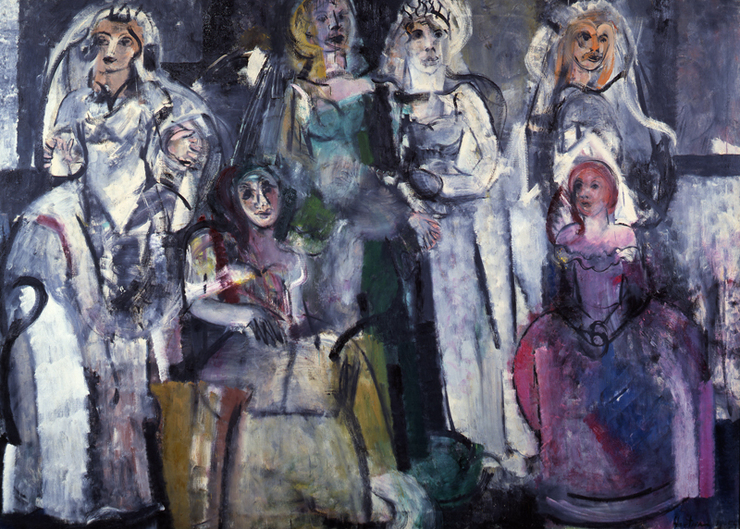 Grace Hartigan, Grand Street Brides, 1954, oil on canvas, 73” x 102”, Whitney Museum of American Art, New York.
Grace Hartigan, Grand Street Brides, 1954, oil on canvas, 73” x 102”, Whitney Museum of American Art, New York.
Grace Hartigan exhibited under the name George Hartigan, following in the footsteps of female writers George Eliot and George Sand, so that she would be taken seriously as an artist. She was from the second generation of Abstract Expressionist artists, a group well known for its machismo. And it was the 1950s.
Hartigan was one of the few Abstract Expressionists who included recognizable motifs in her paintings, rendering them with her emotive and animated brushwork.
Grand Street Brides is Hartigan’s most famous painting. It depicts mannequins in the storefront window of a bridal shop near her apartment in Manhattan’s Lower East Side, a neighborhood in which arranged marriages among the local immigrant population were common. Indeed, each mannequin looks like an actual bride who becomes a commodity in this context much like the sex that Pablo Picasso’s prostitutes sell in Les Demoiselle d’Avignon. Hartigan’s compositional references to Picasso’s earlier canvas unquestionably were intentional.
 Grace Hartigan, Grand Street Brides, 1954, oil on canvas, 73” x 102”, Whitney Museum of American Art, New York.
Grace Hartigan, Grand Street Brides, 1954, oil on canvas, 73” x 102”, Whitney Museum of American Art, New York.
 Grace Hartigan, Grand Street Brides, 1954, oil on canvas, 73” x 102”, Whitney Museum of American Art, New York.
Grace Hartigan, Grand Street Brides, 1954, oil on canvas, 73” x 102”, Whitney Museum of American Art, New York.
 Grace Hartigan, Grand Street Brides, 1954, oil on canvas, 73” x 102”, Whitney Museum of American Art, New York.
Grace Hartigan, Grand Street Brides, 1954, oil on canvas, 73” x 102”, Whitney Museum of American Art, New York.